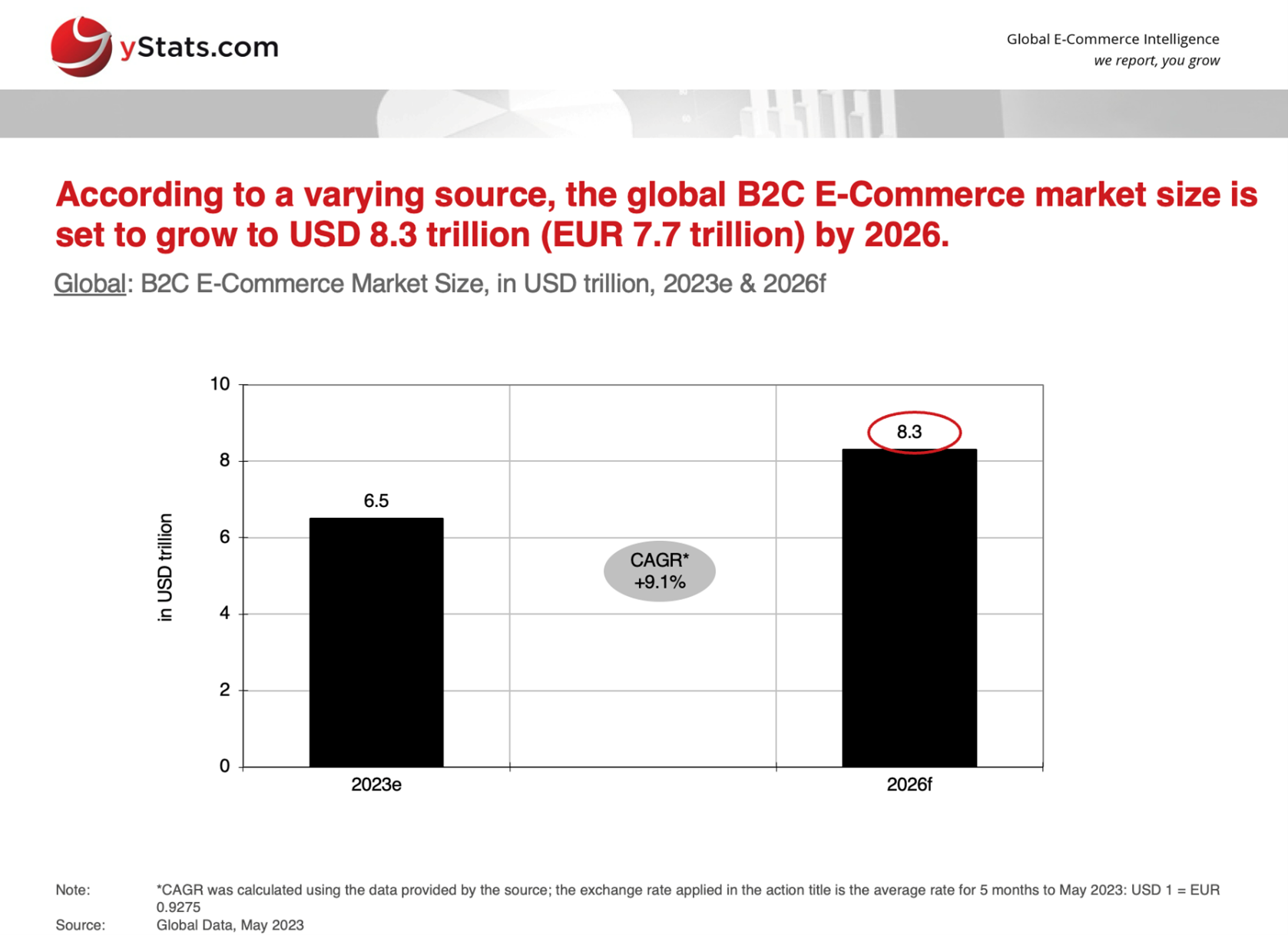The global B2C e-commerce market is undergoing significant transformation, marked by rapid advancements and shifts in consumer behavior. According to forecasts presented in yStats.com’s publication “Global Trends in B2C E-Commerce & Innovations in Online Payments 2024,” the sector is poised for substantial growth, driven by innovations in online payments and the adoption of new technologies. The global B2C e-commerce market size is expected to surpass EUR 7 trillion by 2026, showcasing an impressive growth trajectory, according to Global Data.
Driving Forces Behind Global E-Commerce Growth
The primary drivers of global e-commerce growth include technological advancements and innovations in online payment systems. The proliferation of smartphones and increased internet accessibility have facilitated the growth of online shopping, making it more convenient for consumers worldwide. The majority of global internet users will shop online by 2024, significantly boosting the e-commerce sector. Additionally, the development of secure and efficient online payment methods has further bolstered consumer confidence in e-commerce transactions.

Digital Payment Innovations Enhance E-Commerce Experience
Innovations in digital payments are at the core of the e-commerce model. The introduction of real-time payment systems and mobile wallets has revolutionized the way consumers conduct online transactions. Platforms such as PayPal, Alipay, and Apple Pay are leading the charge, providing secure, quick, and user-friendly payment solutions. Real-time payment systems are predicted to grow reflecting their increasing importance in the e-commerce ecosystem. Furthermore, the implementation of digital currencies and blockchain technology is set to enhance the efficiency and security of online payments, offering new opportunities for e-commerce platforms and consumers alike.
Regional Insights and Market Dynamics
In North America, the e-commerce market is characterized by high internet penetration and a mature online shopping environment. Leading e-commerce platforms like Amazon and eBay continue to dominate the market, driven by advanced logistics networks and a focus on customer experience.
Europe’s e-commerce landscape is diverse, with varying levels of market maturity across different countries. The region is witnessing increased cross-border e-commerce, facilitated by harmonized regulations and improved payment systems. Countries like the UK and Germany are leading the market, while Southern and Eastern European countries are catching up.
The Asia-Pacific region is the fastest-growing e-commerce market, driven by rising internet penetration and a burgeoning middle class. China remains the largest e-commerce market globally, with platforms like Alibaba and JD.com at the forefront. Southeast Asian countries are also experiencing rapid growth, supported by increasing smartphone usage and digital payment adoption. By 2027, the livestreaming retail e-commerce sales in the Asia-Pacific region are projected to reach EUR 285.4 billion, according to Euromonitor.
Emerging Markets and Technological Integration
Emerging markets in Latin America, Africa, and the Middle East are also experiencing significant growth in e-commerce. These regions are benefiting from increased internet accessibility and the adoption of digital payment solutions. In Latin America, Mercado Libre dominates the market, leveraging AI to enhance customer experience and streamline operations.
In Africa, Jumia, and Souq are leading the charge, capitalizing on growing internet usage and mobile connectivity. The Middle East e-commerce market is predicted to grow driven by strategic initiatives and increasing consumer adoption of online shopping.
AI’s Role in the Global E-Commerce Landscape
The integration of advanced technologies such as artificial intelligence, machine learning, and augmented reality is transforming the e-commerce experience. These technologies are enhancing personalization, improving customer service, and streamlining supply chain operations. The use of AI in e-commerce is projected to continue to increase annually, highlighting its critical role in driving industry growth. Additionally, big data analytics provide valuable insights into consumer behavior, enabling businesses to make informed decisions and optimize their operations.
The global B2C e-commerce market is expected to maintain its growth trajectory, driven by ongoing digitalization and the entry of new players. However, the sector faces challenges such as cybersecurity threats, regulatory complexities, and the need for robust logistics infrastructure. Addressing these issues, along with adapting to rapidly evolving consumer preferences and incorporating sustainability practices, will be crucial for future success.
About yStats.com
Recognized as the go-to primary destination for ecommerce industry analysis and payments market data, yStats.com is a leading secondary market research and business intelligence firm specializing in global B2B and B2C E-commerce, payments, and fintech trends. Established in 2005 by Yücel Yelken, the firm provides comprehensive market reports and analyses. yStats.com offers indispensable insights, forecasts, and statistical data, primarily through comprehensive market reports. Trusted by multinational enterprises including Fortune 500 corporations, investors, and organizations, its reports have been featured by Forbes, The Wall Street Journal, and the World Economic Forum.